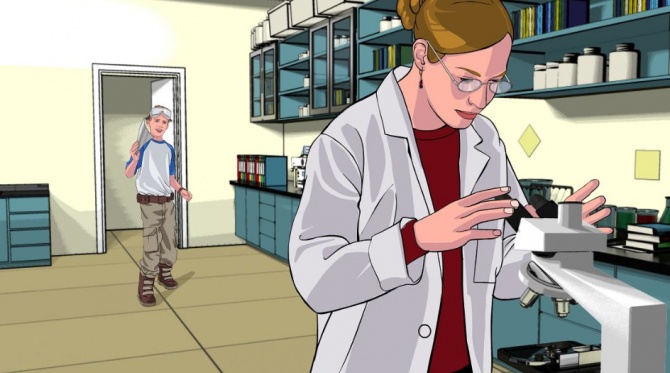20.109(F09): Mod 2 Day 2 Measuring system performance
Contents
Measuring System Performance
Part 1: Beta-galactosidase assay
The bacterial photography system you are studying [described in reference] modifies a signaling pathway in E. coli so light striking the cell can be converted to a detectable output (beta-galactosidase enzyme). A “black box” depiction of the system looks like:
Some of the details within each box are:
This figure is more detailed but harder to decipher without prior understanding of several aspects of the system. For example, light at 660nm is detected by the input-sensing device, turning it off. Light-sensing requires the combined action of two sets of proteins: Cph8, itself a fusion of a light-sensing protein called Cph1 that comes from an algae attached to a transmembrane signaling protein called EnvZ, and phycobilin producing proteins that generate accessory pigments needed for the light-sensing protein to work. The input sensing device generates a signal within the cell’s osmoregulation pathway (OmpR is the signal carrier), changing the activity of an OmpR regulated promoter that is directing transcription of the output: lacZ….whew! The black boxes were a whole lot easier.
You should perform assays on your overnight liquid cultures that were grown in the dark and the light. Activity calculations for these samples will be part of your assignment for next time.
Beta-galactosidase assay
With this assay you will determine the amount of beta-galactosidase activity associated with each sample of cells. You will perform assays of each sample in triplicate to gain some confidence in the values you measure. A table is included here to help you organize your assay, but you can make one of your own if you prefer.
- Make 1 ml of a 1:10 dilution of each cell sample, using Zbuffer-BME as the diluent, then use 100 ul of this dilution to make another 1:10, for a final concentration of 1:100.
- Add 400 μl of Zbuffer-BME to 13 eppendorf tubes labeled 0-12.
- Add 100 μl of the appropriate cell dilution to each tube (1:100 of no IPTG in tubes 1-3 etc). See chart below for guidance. Add 100 ul of Zbuffer-BME to tube 0, to serve as your blank.
- Next you will lyse the cells by add 20 μl of 0.1% SDS to each eppendorf.
- To better lyse the cells, you should also add 30 μl of chloroform (CHCl3) to each tube. Do this in the hood since chloroform is volatile and toxic. You will need to hold the pipet tip close to the eppendorf as you move between the chloroform stock bottle and your eppendorfs since chloroform has a low surface tension and will drip from you pipetmen. Be sure to dispose of your pipet tips in the chloroform waste container located on the right side of the hood.
- To really really lyse the cells, vortex the tubes for 10 seconds each. You should time these precisely since you want the replicates to be treated as identically as possible.
- Start the reactions by adding 100 μl of ONPG to each tube at 10 second intervals, including your blank.
- Stop the reactions by adding 250 μl of Na2CO3 to each tube at 10 second intervals once sufficient yellow color has developed. “Sufficient” is defined as yellow enough to give a reliable reading in the spectrophotometer, best between 0.3 and 1.0. Be sure to note the time you are stopping the reactions. Also be sure to remember that adding the Na2CO3 makes the reactions more yellow.
- When all your samples have been stopped, add 250 μl of Na2CO3 to the blank and spin all the tubes in the microfuge for 1 minute at 13,000 RPM to pellet any cell debris.
- Move 0.5 ml of each reaction to plastic cuvettes and read the absorbance at 420nm. These values reflect the amount of yellow color in each tube.
- Read the absorbance of each at 550 nm. These values reflect the amount of cell debris and differences in the plastic cuvettes themselves.
- Calculate the beta-galactosidase activity in each sample according to the following formula:
- Beta-gal Units = Abs at 420 minus (1.75 times Abs at 550nm) all divided by the product of time in minutes, volume of cells (from original culture) in ml and OD600 (of the original culture), then all times 1000.
- Dispose of your samples properly. Place all cuvettes and tubes in the chloroform waste container in the hood.
Part 2: Black and white photography
Retrieve the Petri dishes you set up last time and compare the appearance of the light and dark grown samples. Because the dark grown cells were in a completely dark box, the difference between the two plates is the greatest contrast you can expect in your bacterial photographs. Media containing S-gal is available for you to supplement with antibiotics and cells as you did last time.
Next decide what image you would like to photograph. Generate a computer file with this image and print it to a transparency. Transparencies will be available in the lab for you to use as masks, taping them to the back of the Petri dish before incubating. The goal is to have each cell growing distinctly in the light or dark, but be sensitive to the fact that light can bounce around and can blur the resulting image. As much as possible you want a setup where light hits the cells then continues through as little agar as possible, then hits black background and dies. In general, it’s better to have a dark background and a light image rather than the other way around. To darken the dark parts of your photo, you might want to print it on two transparencies and use them both to mask your Petri dish.
DONE!